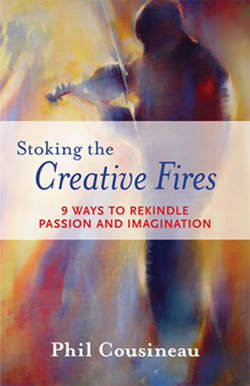Читать книгу Stoking the Creative Fires - Phil Cousineau - Страница 12
На сайте Литреса книга снята с продажи.
THE CIRCULAR ADVENTURE
ОглавлениеThat day, an image rose in my mind that reminded me of Campbell's idea of the hero's journey. The myriad-minded mythologist, combined the ancient circular symbol of the soul with the eternal wheel of life to create a dynamic image of the search for self-knowledge. For years, I'd kept a sketch of his simple diagram pinned to a corkboard in my writing studio. It helped me visualize the dramatic journey that underwrites movies, novels, and plays. I came to love the adrenaline rush I got from recognizing the three stages of the mythic journey in the three acts of dramatic structure. And on this fateful day in Galway, I recognized in that same iconic voyage the three stages of the creative journey.
For over twenty years, I had taught the hero's journey model in Myth and Movie workshops from the American Film Institute to the University of London. I had adapted it as The Pilgrim's Journey for gatherings of spiritual seekers in monasteries and churches, and even as The Business Journey for corporations looking for a competitive edge. The journey model is useful in all these contexts because it offers a clear image of the adventure of self-knowledge, the mystery of change, and the promise of transformation. But until that storm-clouded day in Galway, I hadn't recognized it as a road map for the adventure of creativity.
For millennia, the circle has been the symbol for the Great Round of life. Philosophers, writers, and artists from Aristotle to Robert Frost have considered its power. Van Gogh wrote to his brother, “Life is probably round.” Chuang Tsu also comes to mind, “At the still point in the center of the circle one can see the infinite in all things.” Around and around we go on the circular journey. Filmmaker David Lynch sees every movie as a circular movement; choreographer Twyla Tharp uses overlapping circles to chart the progress of her ongoing projects. Albert Einstein considered the circle an immortal image. Years ago in an interview I did with beloved religion historian Huston Smith for our book, The Way Things Are, he mused, “[T]here is something magical about a circle. For one thing it is geometric; it can encompass more space than any other shape. But this is more than just mathematical. It is also symbolic. A circle travels without leave-taking. So it combines a journeying with a center.” Finally, painter Francis Picabin mused, “Our heads are round so that thoughts can change direction.” My revelation in the Galway bookstore showed me that the “center” he described could be my center and your center, and that the journey he referred to could be the long, hard journey of creativity. In turn, being stuck creatively means you're caught in a vicious circle and must turn around and try another way.
The English art critic Herbert Read, writing of Paul Klee in his book The Meaning of Art, observed, “The artist must penetrate to the source of the life force, the power-house of all time and space, and only then will he have the energy and freedom to create with the proper technique a vital work of art.” For Brenda Ueland, that “source of the life force” is always the artist. “There is only one you,” she wrote. “Consequently, if you speak or write from yourself you cannot help being original. So remember two things: you are talented and you are original.” The moral is we must learn to say something new, from the center, from our core, as honestly as possible. If we do so, we can't help but be original; it may not be great, but at least it will be original. That's all we can ever hope to control.
Igniting your creative fire requires focus. And it takes practice, focused practice—determined practice of the thing you love until you do it right, until it becomes natural, a habit, a way to conduct yourself. “I believe we learn by practice,” said Martha Graham. “Whether it means to learn to dance by practicing dancing or to learn to live by practicing living, the principles are the same.” This takes great resolve; it also requires the ability to imagine what you do before you do it. This is harder than it sounds; it requires a leap of faith, a respect for the utter mystery of creativity. Fortunately, great spirits from Lao Tzu to Antoine de Saint-Exupéry, Willa Cather, and Fred Astaire have partly demystified the process for us by telling us how to begin. Take the first step. And then take the next step and the one after that. If you take enough steps, it's called a journey.
Fire Within, oil on canvas. Self portrait by Laila Carlson, 2007.
